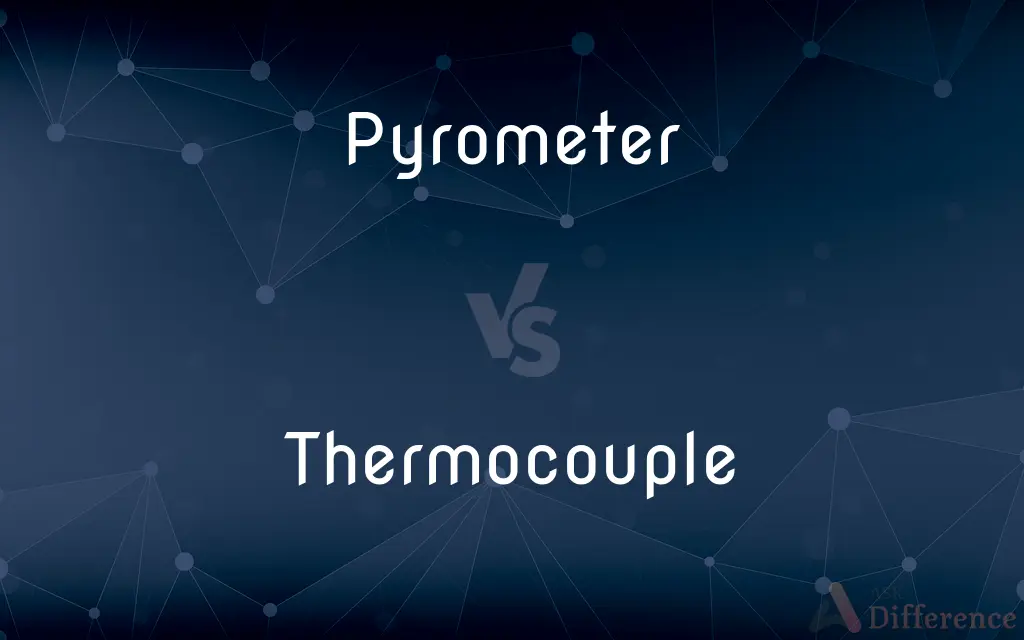Pyrometer vs. Thermocouple — What's the Difference?
By Tayyaba Rehman & Fiza Rafique — Updated on April 2, 2024
A pyrometer measures high temperatures from a distance using radiation principles, while a thermocouple measures temperature through electrical signals generated by heat at a contact point.

Difference Between Pyrometer and Thermocouple
Table of Contents
ADVERTISEMENT
Key Differences
Pyrometers are instruments designed to measure high temperatures without making physical contact with the object being measured, utilizing the principles of radiation to determine temperature. Whereas, thermocouples directly measure temperature through physical contact, relying on the thermoelectric effect where a voltage is generated in response to temperature differences across two dissimilar metals.
Pyrometers are particularly useful in situations where the object's temperature is too high for direct contact methods or where the object is moving or contained within a hostile environment. On the other hand, thermocouples offer a simple, robust, and often more accurate method for measuring a wide range of temperatures, making them suitable for various industrial and laboratory applications.
The accuracy of a pyrometer can be affected by the emissivity of the object's surface, which can vary widely depending on material and surface finish. Thermocouples, however, can provide precise temperature measurements regardless of the object's surface properties, as long as there is good thermal contact with the measurement point.
Pyrometers typically require calibration for different types of materials to account for variations in infrared emissivity, while thermocouples can be used across a wide range of materials without the need for such adjustments, provided the correct type of thermocouple is selected for the temperature range and environmental conditions.
The choice between a pyrometer and a thermocouple often depends on the application's specific requirements, such as temperature range, accessibility of the object, the need for non-contact measurement, and accuracy requirements. Pyrometers excel in high-temperature, inaccessible, or moving targets, while thermocouples are preferred for their versatility, accuracy, and direct measurement capabilities.
ADVERTISEMENT
Comparison Chart
Measurement Principle
Radiation-based, non-contact
Thermoelectric effect, contact
Temperature Range
High temperatures, typically above 600°C
Wide range, from -270°C to 1800°C
Application Environment
Inaccessible, high-temperature, or moving objects
Direct contact with the object is feasible
Accuracy
Dependent on material's emissivity
High, with direct contact
Calibration
Requires material-specific calibration
Minimal, specific to thermocouple type
Compare with Definitions
Pyrometer
A device that determines temperature from a distance by detecting and measuring the radiation emitted by an object.
To ensure safety, the firefighters used a pyrometer to gauge the temperature of the burning building.
Thermocouple
Widely used in science and industry for its simplicity and wide temperature range.
Thermocouples monitored the temperature variations during the chemical reaction process.
Pyrometer
An instrument for measuring high temperatures, especially in industrial processes.
The steel mill used a pyrometer to accurately monitor the temperature of molten steel.
Thermocouple
Offers direct contact temperature measurements, providing high accuracy.
The thermocouple was inserted directly into the liquid to obtain an accurate temperature reading.
Pyrometer
Utilizes optical and infrared technology to measure temperature without physical contact.
The ceramic kiln’s temperature was measured using an optical pyrometer.
Thermocouple
A device consisting of two dissimilar conductors that generate a voltage proportional to temperature.
The laboratory used a thermocouple to measure the temperature inside the furnace accurately.
Pyrometer
Requires calibration based on the emissivity of the target material.
The pyrometer was calibrated for different metal surfaces before conducting temperature measurements.
Thermocouple
Different types are available for various temperature ranges and environments.
A Type K thermocouple was used due to its versatility and resistance to oxidation.
Pyrometer
Often used in situations where contact measurement is impossible or impractical.
A pyrometer measured the temperature of the rocket engine during the test fire.
Thermocouple
Requires consideration of the thermoelectric effect for proper application.
Engineers selected a specific type of thermocouple to match the operational temperature range of the equipment.
Pyrometer
A pyrometer is a type of remote-sensing thermometer used to measure the temperature of distant objects. Various forms of pyrometers have historically existed.
Thermocouple
A thermocouple is an electrical device consisting of two dissimilar electrical conductors forming an electrical junction. A thermocouple produces a temperature-dependent voltage as a result of Seebeck effect, and this voltage can be interpreted to measure temperature.
Pyrometer
An instrument for measuring high temperatures, especially in furnaces and kilns
Radiation pyrometer
Optical pyrometer
Thermocouple
A thermoelectric device for measuring temperature, consisting of two wires of different metals connected at two points, a voltage being developed between the two junctions in proportion to the temperature difference.
Pyrometer
Any of various thermometers used for measuring high temperatures.
Thermocouple
A thermoelectric device used to measure temperatures accurately, especially one consisting of two dissimilar metals joined so that a potential difference generated between the points of contact is a measure of the temperature difference between the points.
Pyrometer
A thermometer designed to measure high temperatures.
Thermocouple
(physics) A transducer consisting of two different metals welded together at each end; a voltage is produced that is proportional to the difference in temperature between the two junctions (one of which is normally held at a known temperature)
Pyrometer
An instrument for measuring the thermal expansion of solids.
Thermocouple
A thermoelectric couple.
Pyrometer
An instrument used for measuring the expansion of solid bodies by heat.
Thermocouple
A kind of thermometer consisting of two wires of different metals that are joined at both ends; one junction is at the temperature to be measured and the other is held at a fixed lower temperature; the current generated in the circuit is proportional to the temperature difference
Pyrometer
An instrument for measuring degrees of heat above those indicated by the mercurial thermometer.
Pyrometer
A thermometer designed to measure high temperatures
Common Curiosities
What is a pyrometer used for?
Pyrometers are used for measuring high temperatures, especially in industrial environments where direct contact is not possible.
How does a thermocouple work?
A thermocouple works by generating a voltage in response to temperature differences between two dissimilar metals, which can be converted into a temperature reading.
Can pyrometers measure temperature of any material?
Yes, but accuracy varies with the material’s emissivity; calibration may be required for accurate measurements.
What types of thermocouples are there?
There are several types, including Types K, J, T, E, and N, each suited to different temperature ranges and environments.
Can thermocouples measure very high temperatures?
Yes, some types of thermocouples can measure temperatures up to 1800°C.
Are pyrometers accurate?
Their accuracy depends on the material’s emissivity and the device's calibration. They can be very accurate when properly configured.
What is the temperature range of a thermocouple?
Thermocouples can measure a wide range of temperatures, typically from -270°C to 1800°C, depending on the type.
Do pyrometers need to be calibrated often?
Calibration frequency depends on usage and the precision required; they may need recalibration for different materials.
How do environmental conditions affect pyrometer readings?
Dust, smoke, or gases in the environment can interfere with the radiation signal, affecting accuracy.
Do pyrometers require physical contact with the object?
No, pyrometers measure temperature from a distance without making physical contact.
How do I choose between a pyrometer and a thermocouple?
The choice depends on your specific needs, including temperature range, the feasibility of contact, and the environment.
Is a special type of pyrometer required for different materials?
Not a specific type, but calibration adjustments may be needed to account for variations in emissivity among different materials.
What affects a thermocouple's accuracy?
Factors include the type of metals used, the temperature range, and the quality of the junction.
Are thermocouples expensive?
Generally, thermocouples are cost-effective, especially when considering their durability and range of applications.
Can a pyrometer measure temperature through glass?
This depends on the type of pyrometer and the glass; some infrared pyrometers may have difficulty measuring through certain types of glass.
Share Your Discovery

Previous Comparison
Rimfire vs. Centerfire
Next Comparison
Poison vs. VenomAuthor Spotlight
Written by
Tayyaba RehmanTayyaba Rehman is a distinguished writer, currently serving as a primary contributor to askdifference.com. As a researcher in semantics and etymology, Tayyaba's passion for the complexity of languages and their distinctions has found a perfect home on the platform. Tayyaba delves into the intricacies of language, distinguishing between commonly confused words and phrases, thereby providing clarity for readers worldwide.
Co-written by
Fiza RafiqueFiza Rafique is a skilled content writer at AskDifference.com, where she meticulously refines and enhances written pieces. Drawing from her vast editorial expertise, Fiza ensures clarity, accuracy, and precision in every article. Passionate about language, she continually seeks to elevate the quality of content for readers worldwide.















































